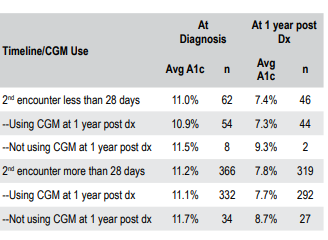Abstract: Shorter follow-up between diagnosis of type 1 diabetes (T1D) to next encounter associates with improved glycemic outcomes
R. McDonough1,2, S. Tsai1,2, M. Barnes1, C. Vandervelde1, P. Prahalad3, D. Maahs3, S. Patton4, M. Clements1,2
1Children’s Mercy - Kansas City, Kansas City, United States, 2University of Missouri - Kansas City, School of Medicine, Kansas City, United States, 3Stanford University, Palo Alto, United States, 4Nemours Children’s Health, Jacksonville, United States
Introduction: T1D diagnoses require intensive education at new-onset to allow for safe care at home. Educational content can be overwhelming for patient/ families, and should be delivered in small, digestible sections. Earlier support and education from the diabetes-care team is essential to improved outcomes in glycemia.
Objectives: To assess if shorter time between initial T1D diagnosis is associated with improved glycemic outcomes, as measured by A1c, at 1 year post diagnosis.
Methods: Youth, < 18 years old, newly diagnosed with T1D during the COVID-19 (3/17/2020 – 9/30/22), at a Pediatric Diabetes Center in Midwest USA engaged in the T1DX-QI Consortium were included. To reduce cognitive burden on new-onset patients/families, we deliver new-onset education in two separate sessions, delivered in the ambulatory or telehealth setting, approximately 3 weeks apart. Patients were categorized by CGM use, and elapsed days between T1D diagnosis and next educational session after new-onset.
Results: With active QI initiatives aimed to improve clinical access throughout the study, the percentage of patients with > 28 days from initial diagnosis to first follow-up shortened over the observational period. A1c at diagnosis was 11%, and 11.2% in the < 28 days and > 28 day cohorts, respectively. A1c at 1 year, was lower, 7.4% vs 7.8%, in those who had a shorter time to first follow-up. CGM use, and shorter duration between diagnosis and first follow-up/second educational class, are associated with lower A1c. Lowest A1c was noted in the CGM-using group with < 2 week between encounters.

Conclusions: Education in the new onset period is critical to successful T1D management. Earlier follow-up after T1D diagnosis is associated with lower A1c. Time from T1D diagnosis to next diabetes-related clinical encounter may have long-term impact on glycemic outcomes. Clinical teams may consider earlier scheduled follow-up after diagnosis and refine educational materials to deliver content over this shorter timeframe.
Link: https://www.react-profile.org/upload/KIT/system/uploads/ISPAD2023_Abstracts.pdf
